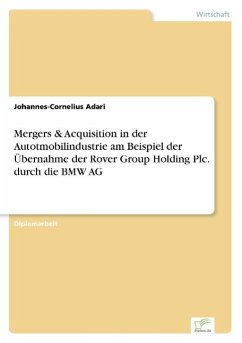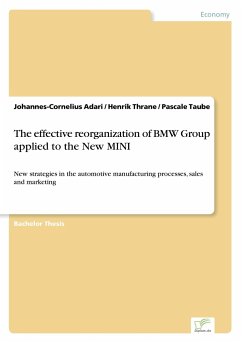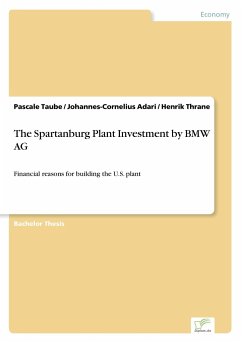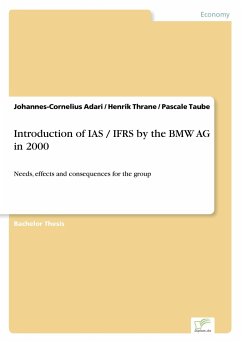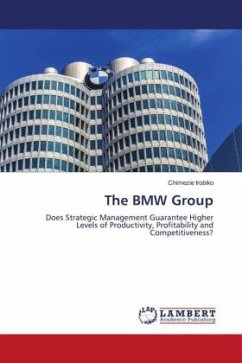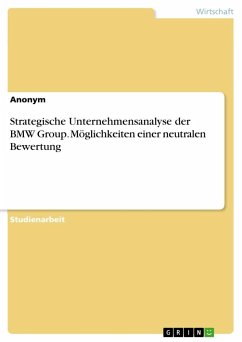Bachelor Thesis from the year 2002 in the subject Business economics - Trade and Distribution, grade: 1,9, Hogeschool Zeeland (Economics), language: English, abstract: Inhaltsangabe:Abstract:
The target of this case study is to present and analyse the drastic false estimations made by BMW in planning and realising the Rover transition as well as its consequences. The worked out mistakes should be generalized in order to give opportunities of their avoidance for future M&A cases.
After working out the M&A basics in the 1st chapter, the 2nd chapter deals with the reasons of BMW Management to buy another international manufacturer and gives a clue why the choice fell just on Rover.
It opens with an overview of the economic development during the 6 years time period of the Rover takeover. After this, the economic and political environment is shown, also the market situation in the automobile segment in the year of the takeover, followed by the business course and goals of BMW as well as their alternatives. This chapter closes with the strategy and enterprise philosophy of BMW and with a list of the of the Rover Group s assets in 1994.
In the 3rd and 4th chapters of this case study the mistakes of the BMW management attempting to integrate Rover into the BMW portfolio are shown and analysed, as well as its consequences for BMW and Rover.
The 5th chapter will end with the conclusion, why the Rover takeover went wrong.
Zusammenfassung:
Ziel der Arbeit ist es, die strategischen Ziele, die Tragweite und die möglichen Folgen von M&A-Transaktionen in den Bereichen Finanzen (Investitionen und operatives Geschäft), Unternehmensführung- und Organisation sowie der Unternehmenskultur anhand dieses Unternehmenskaufes zu untersuchen.
Dazu wurde die Arbeit in 6 Teile untergliedert.
Im 1. Teil werden die allgemeinen M&A-Grundlagen beleuchtet, insbesondere die Ziele, Erscheinungsformen, rechtlichen Rahmenbedingungen als auch die Vor- und Nachteile von M&A-Transaktionen.
Im 2. Teil wird das Umfeld von BMW im Jahre 1994 analysiert, die strategischen Gestaltungsmöglichkeiten dargestellt und untersucht, warum gerade die britische Rover Group der für BMW geeignete Übernahmekandidat zu sein schien.
Im 3. und 4. Teil wird die Transaktion und ihre Folgephasen untersucht und die Gründe für das Scheitern der Übernahme herausgearbeitet.
Die Zusammenfassung und kritische Bewertung der dem BMW Vorstand unterlaufenen Entscheidungsfehler bei der Auswahl und Führung von Rover erfolgt im 5. Teil.
Die Arbeit schließt ab mit dem 6. Teil, in dem die finanziellen Auswirkungen der Transaktion kommentiert und anhand von 10 Säulen- und Liniendiagrammen erläutert werden.
Inhaltsverzeichnis:Table of Contents:
1.Introduction - Mergers & Acquisitions (M&A)5
1.1Goals of M&A5
1.1.1Economies of scale5
1.1.2Economies of scope6
1.1.3Reduction of economical risks6
1.2Typical achievements of economies of scope7
1.2.1Research and development area7
1.2.2Sourcing7
1.2.3Finance7
1.2.4Production7
1.2.5Distribution8
1.3Legal problems of M&A8
1.4Features of M&A9
1.4.1Production level9
1.4.1.1Horizontal mergers9
1.4.1.2Vertical mergers9
1.4.1.3Diagonal mergers9
1.4.2Duration9
1.4.3Degree of cooperation10
1.4.3.1Contractual basis of cooperation10
1.4.3.2Investment acquisitions10
1.4.3.3Takeover of assets items10
1.4.3.4Fusion10
1.4.4Forms of M&A10
1.4.4.1Cartels11
1.4.4.2Silent cooperation and coordinated behaviour11
1.4.4.3Agreements11
1.4.4.4Syndicate and participation11
1.4.4.5Trade associations11
1.4.4.6Joint venture11
1.4.4.7Group12
1.4.4.8Fusion12
1.5Distinction of national, international and multinati...
Hinweis: Dieser Artikel kann nur an eine deutsche Lieferadresse ausgeliefert werden.
The target of this case study is to present and analyse the drastic false estimations made by BMW in planning and realising the Rover transition as well as its consequences. The worked out mistakes should be generalized in order to give opportunities of their avoidance for future M&A cases.
After working out the M&A basics in the 1st chapter, the 2nd chapter deals with the reasons of BMW Management to buy another international manufacturer and gives a clue why the choice fell just on Rover.
It opens with an overview of the economic development during the 6 years time period of the Rover takeover. After this, the economic and political environment is shown, also the market situation in the automobile segment in the year of the takeover, followed by the business course and goals of BMW as well as their alternatives. This chapter closes with the strategy and enterprise philosophy of BMW and with a list of the of the Rover Group s assets in 1994.
In the 3rd and 4th chapters of this case study the mistakes of the BMW management attempting to integrate Rover into the BMW portfolio are shown and analysed, as well as its consequences for BMW and Rover.
The 5th chapter will end with the conclusion, why the Rover takeover went wrong.
Zusammenfassung:
Ziel der Arbeit ist es, die strategischen Ziele, die Tragweite und die möglichen Folgen von M&A-Transaktionen in den Bereichen Finanzen (Investitionen und operatives Geschäft), Unternehmensführung- und Organisation sowie der Unternehmenskultur anhand dieses Unternehmenskaufes zu untersuchen.
Dazu wurde die Arbeit in 6 Teile untergliedert.
Im 1. Teil werden die allgemeinen M&A-Grundlagen beleuchtet, insbesondere die Ziele, Erscheinungsformen, rechtlichen Rahmenbedingungen als auch die Vor- und Nachteile von M&A-Transaktionen.
Im 2. Teil wird das Umfeld von BMW im Jahre 1994 analysiert, die strategischen Gestaltungsmöglichkeiten dargestellt und untersucht, warum gerade die britische Rover Group der für BMW geeignete Übernahmekandidat zu sein schien.
Im 3. und 4. Teil wird die Transaktion und ihre Folgephasen untersucht und die Gründe für das Scheitern der Übernahme herausgearbeitet.
Die Zusammenfassung und kritische Bewertung der dem BMW Vorstand unterlaufenen Entscheidungsfehler bei der Auswahl und Führung von Rover erfolgt im 5. Teil.
Die Arbeit schließt ab mit dem 6. Teil, in dem die finanziellen Auswirkungen der Transaktion kommentiert und anhand von 10 Säulen- und Liniendiagrammen erläutert werden.
Inhaltsverzeichnis:Table of Contents:
1.Introduction - Mergers & Acquisitions (M&A)5
1.1Goals of M&A5
1.1.1Economies of scale5
1.1.2Economies of scope6
1.1.3Reduction of economical risks6
1.2Typical achievements of economies of scope7
1.2.1Research and development area7
1.2.2Sourcing7
1.2.3Finance7
1.2.4Production7
1.2.5Distribution8
1.3Legal problems of M&A8
1.4Features of M&A9
1.4.1Production level9
1.4.1.1Horizontal mergers9
1.4.1.2Vertical mergers9
1.4.1.3Diagonal mergers9
1.4.2Duration9
1.4.3Degree of cooperation10
1.4.3.1Contractual basis of cooperation10
1.4.3.2Investment acquisitions10
1.4.3.3Takeover of assets items10
1.4.3.4Fusion10
1.4.4Forms of M&A10
1.4.4.1Cartels11
1.4.4.2Silent cooperation and coordinated behaviour11
1.4.4.3Agreements11
1.4.4.4Syndicate and participation11
1.4.4.5Trade associations11
1.4.4.6Joint venture11
1.4.4.7Group12
1.4.4.8Fusion12
1.5Distinction of national, international and multinati...
Hinweis: Dieser Artikel kann nur an eine deutsche Lieferadresse ausgeliefert werden.


